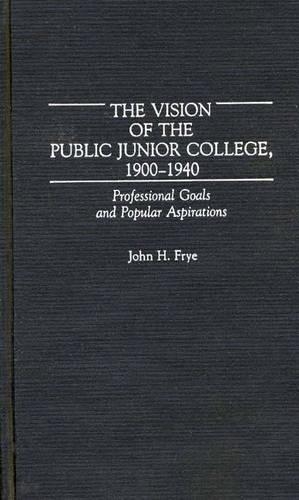
The Vision of the Public Junior College, 1900-1940: Professional Goals and Popular Aspirations
(Hardback)
Publishing Details
The Vision of the Public Junior College, 1900-1940: Professional Goals and Popular Aspirations
By (Author) John H. Frye
Bloomsbury Publishing PLC
Praeger Publishers Inc
30th December 1991
United States
Classifications
Tertiary Education
Non Fiction
378.1543
Physical Properties
Hardback
176
Description
Public junior colleges grew rapidly between 1900 and 1940. During that time, nationally prominent leaders maintained that the junior college should provide a terminal education and prepare students for semiprofessional careers. But students used the junior college as a means to further education and greater professional opportunities. Frye argues that the national vision of the junior college had little impact on its development, and that the junior college evolved to meet the professional goals and aspirations of its students. Frye begins by defining the junior college and the ideology promulgated by leading educators during the first half of the twentieth century. He then places this ideology within the context of the social changes which took place between 1900 and 1940, and examines how the vision of the local junior college conflicted with the national vision. This study offers a valuable overview of the impact of shifting demographic patterns and changing social values on the development of the public junior college in its early years. Educators, historians, and all those interested in community/junior colleges will find this work remarkably lucid and insightful.
Reviews
. . . a very well-written and well-researched book that raises intriguing questions and will force many of us to reexamine our assumptions of the early days of our junior college movement. Mr. Frye is to be congratulated on an innovative, important work, which I recommend to my fellow community and junior college administrators.-Journal for Higher Education Management
A very well-written and well-researched book that raises intriguing questions and will force many of us to reexamine our assumptions of the early days of the junior college movement. Mr. Frye is to be congratulated on an innovative, important work. . . .-Journal for Higher Education Management
Frye makes an important contribution to the still sparse historical literature about the public junior college.-American Historical Review
In a well-organized, clearly written, and succinct manner, John Frye examines the formation of the ideology and vision of the junior college between 1900 and 1940. Individuals with limited understanding of this institution will find this book to be an excellent starting point to explore the professional and popular reasons for the development of the junior college.-History of Education Quarterly
." . . a very well-written and well-researched book that raises intriguing questions and will force many of us to reexamine our assumptions of the early days of our junior college movement. Mr. Frye is to be congratulated on an innovative, important work, which I recommend to my fellow community and junior college administrators."-Journal for Higher Education Management
"A very well-written and well-researched book that raises intriguing questions and will force many of us to reexamine our assumptions of the early days of the junior college movement. Mr. Frye is to be congratulated on an innovative, important work. . . ."-Journal for Higher Education Management
"Frye makes an important contribution to the still sparse historical literature about the public junior college."-American Historical Review
"In a well-organized, clearly written, and succinct manner, John Frye examines the formation of the ideology and vision of the junior college between 1900 and 1940. Individuals with limited understanding of this institution will find this book to be an excellent starting point to explore the professional and popular reasons for the development of the junior college."-History of Education Quarterly
Author Bio
JOHN H. FRYE is a member of the history faculty at Triton College. He has published several articles and has been in community college teaching and administration for the past twenty years.
